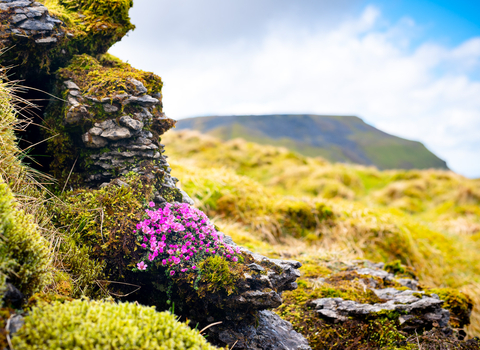A home for endemic plants and fungi
Ingleborough is one of four places in the UK where you can find Teesdale violets, one of just two places in Yorkshire you'll find the beautiful purple saxifrage, and the only place in the world where you can enjoy the tiny white stars of Yorkshire sandwort.
Ingleborough's limestone pavements are so unusual that they host rare and amazing ferns, lichens and mosses, as well as carpets of sweet-smelling wild thyme and rock-rose. In fact, it's estimated that Ingleborough and the surrounding landscape is home to a third of the UK’s plant species. Species which in turn provide places for butterflies and birds to rest, feed and find a home.
We’ve been working hard across Ingleborough to help wildlife thrive, even abseiling down cliffs to collect seeds! Combining our own experience with advice from partners and others (including Royal Botanic Gardens, Kew), we’ve deployed new methods to help ferns grow by spraying their seeds into the cracks of the limestone pavement, and roamed our conservation grazing cattle across the limestone grasslands.
We can see the first tentative flush of greenery returning thanks to seed collection and our innovative upland restoration and planting techniques.
Many plants were not lost, just sleeping — their seeds just waiting for an opportunity to flourish again.
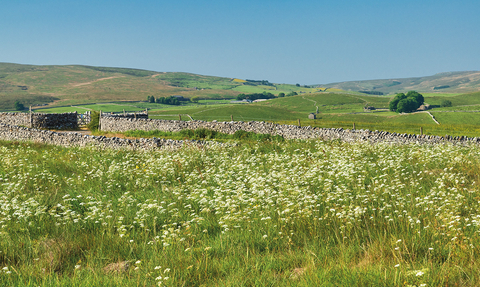
Bellfields Pasture - (C) John Potter
Help Yorkshire’s rarest limestone plants flourish
Plants found nowhere else in the world
The wildflowers around Ingleborough are a spectacle to behold.
From late spring, a wander through the remnants of limestone grasslands of Yorkshire Wildlife Trust’s nature reserves (Ashes Pasture, Brae Pasture, Ashes Shaw) immerses you in colour — yellow of rockrose and the giant buttercup-like globeflowers, delicate pink of bird’s eye primrose, and the many different hues of the dancing mountain pansies.
In time and with more space, these pockets of wild colour could spread right out over the hills, bringing life and vitality to an already iconic landscape.
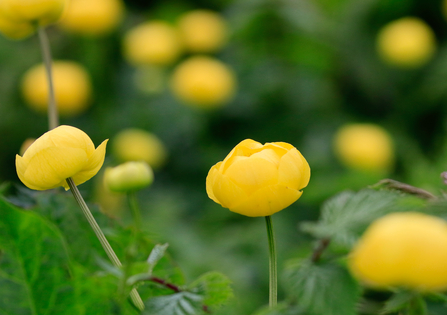
Ashes Pasture - Globeflower (c) Judith Greaves
These hidden gems represent a fraction of what conservationists believe is possible — that Ingleborough could be one of the most important limestone landscapes in the world.
Its unique mix of habitats has given rise to some very rare flowers. Like protected spiked speedwell, with its columns of purple-blue flowers, which clings to just one tiny ledge!
Many of these rarer species are in such small numbers (in single clusters and in some cases found nowhere else in the world), that they are highly vulnerable to damage, bad weather and the effects of the changing climate. Swift action is needed to prevent them from being lost forever.
Our goal is to ensure a larger, joined-up landscape of wild spaces where wildlife can grow and move and flourish, and to then restore and manage it in such a way that these rarer species have the best possible chance of survival.
Ingleborough's magnificent plants and fungi
Purple saxifrage
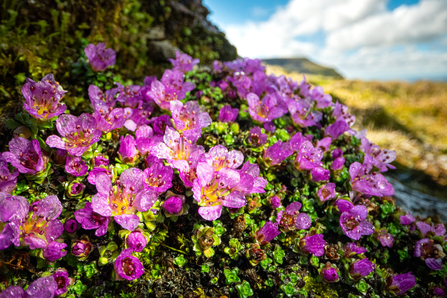
Purple saxifrage on Ingleborough (c) Finn Varney
A very rare plant that can only be found on two mountains in the Yorkshire Dales, Pen-y-ghent and Ingleborough, and was first recorded in the UK on Ingleborough in 1668. Purple saxifrage has small triangular green leaves and bright purple blossoming flowers.
Where to see: On the limestone crags of Ingleborough between February and May - but do not approach cliff edges to look for it!
Teesdale violet
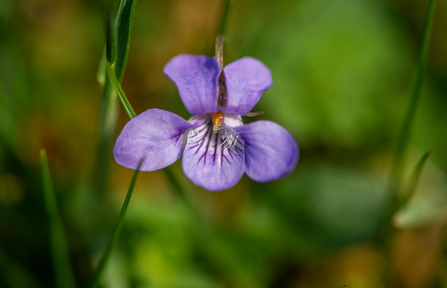
Teesdale violet (c) WWF-UK
Teesdale violet is a tiny purple-flowering plant found on shallow rocky grassland. The violet is only a few millimetres in size.
Nationally scarce, it's found in only four locations in the whole of Britain — which makes our population in Yorkshire especially important.
Where to see: Ingleborough mountain (not on our land) if your eyesight is very good! From mid-March to late April.
Yorkshire sandwort
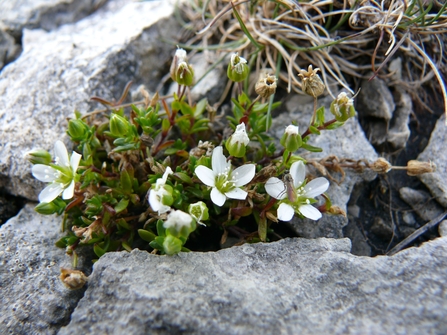
Yorkshire sandwort (c) Kevin Walker
An endemic species, meaning the only place in the world these tiny clusters of white stars are found is on the slopes of Ingleborough. It looks reasonably similar to spring sandwort, and can be spotted on flushes and gravelly areas amongst the limestone cliffs.
Where to see: Ingleborough mountain (not on our land). From May to August.
Mountain pansy
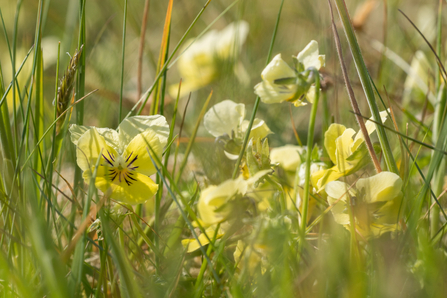
Mountain Pansies - (C) John Potter
A lovely sign of spring, mountain pansies range in colour between yellow and purple with varying amounts of each. They are only found in the upland hills of northern England, Scotland and Wales.
Where to see: Ashes Shaw. Upland grassland and calcareous rocks. From May to August.
Mountain everlasting
Mountain Everlasting (c) Pete Stroh
A short and neat plant (to 20cm) with a small bunch of compact white flowers. Very common in Scotland and Ireland, less common in northern England and rare in the south.
Where to see: Dry grassland on the lower slopes of Ingleborough mountain, flowering from May to July.
Bird’s-eye primrose
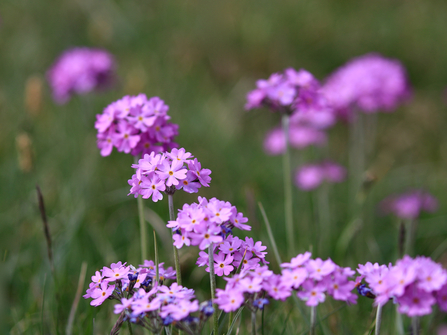
Bird's-eye primrose - South House Pavement (c) Judith Greaves
This delicate little purple flower is found solely in the limestone belt of Yorkshire and Lancashire, and is absent from the rest of the UK — giving it its alternative name ‘Yorkshire primrose’.
Where to see: Southerscales, Ashes Pasture, Ashberry, Braes Pasture, Salt Lake Quarry, NE land in huge numbers. Enjoy in damp grassland from June onwards.
Orchids
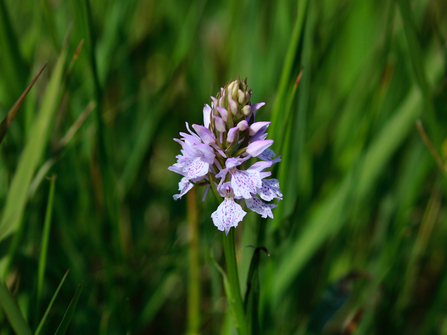
Spotted orchid - Ashes Pasture (c) Judith Greaves
Aside from early purple orchids, most of the orchids found on our Ingleborough reserves appear in June.
Ashes Shaw has early purple orchids, and Ashes Pasture has seven different species of orchid, including heath orchid, bee orchid and occasionally the scarce white orchid. Southerscales has frog orchids and fragrant orchids, and Salt Lake Quarry has frog orchids, bee orchids, and early purple orchids.
Holly fern
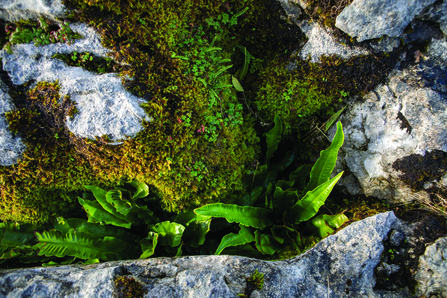
Limestone pavement gryke - Greg Armfield (WWF-UK)
Holly ferns are an evergreen, long-lived, slightly spikey fern. They are well suited to the Yorkshire Dales as they like the deep grykes of open limestone pavement habitats at high altitudes and summer temperatures that aren’t too high! The core area for holly fern in the UK is northern and western Scotland above 600m, and they are rare in the rest of the country.
Where to see: Limestone pavements, year-round.
Parrot waxcap fungi
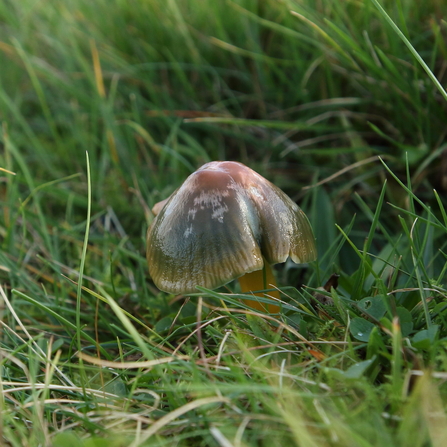
false - Vaughn Matthews (please also tag @vaughnmatthews8 if using on Instagram or @VaughnMatthews2 on Twitter)
A spectacular mushroom with varied colours, mainly between green, yellow and blue with a shiny, slimy cap and stem. Common, but found in small localized populations around unimproved limestone grasslands.
Ingleborough is a great place to see unusual fungi because the grassland is unimproved, meaning the soil quality is poorer. This links to an ancient landscape steeped in folklore and heritage.
Look out for our for future fungi and heritage events on the Wild Ingleborough Eventbrite page.
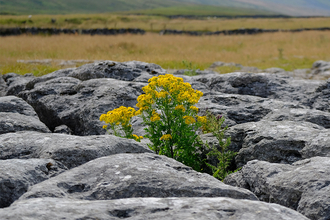
£25 could enable us to grow and plant out five limestone plants from seed
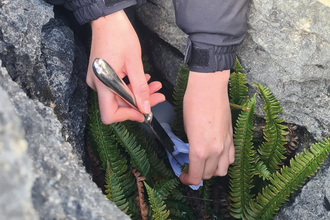
£50 could help to equip and train volunteers to grow and establish montane wild flowers
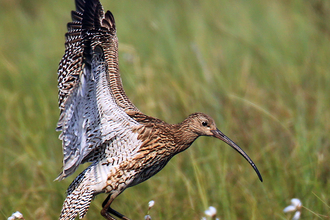
£100 could provide a day of monitoring and surveys to help inform and target our work
A haven for beautiful birds
Ingleborough is a stronghold for breeding curlews – their iconic call the soundtrack to the Dales.
High overhead, you may spy barn owls and kestrels, or a hen harrier performing an exhilarating sky dance.
The pockets of woodland provide a space for willow warbler, tree creeper and cuckoo, and there's the potential for black grouse and ring ouzel to find a more secure home here in the future too.
The limestone grassland and remnants of montane woodland also offer an important home for skylark, curlew and cuckoo, who usher in spring with their distinctive calls.
Curlew
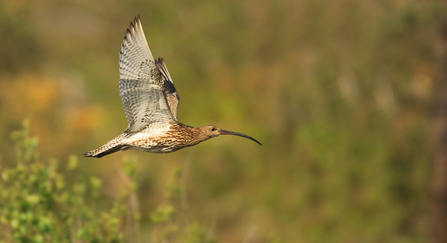
Instantly recognizable for its characteristic curved bill and haunting ‘cur-lee’ call, curlews are ground-nesting birds.
The UK breeding population of curlews is of international importance, with around 30% of the west European population spending winter in the UK. Ingleborough is a stronghold for resident curlew.
But there have been worrying declines in the breeding population in much of the UK. This is due to loss of breeding populations and range, and intensive farming practices.
Devastatingly, curlews were added to the Red List on the UK Conservation Status Report in 2015.
Where to see (or hear): Ashes Pasture, Ashes Shaw, Ribblehead Quarry. Spring.
Cuckoo
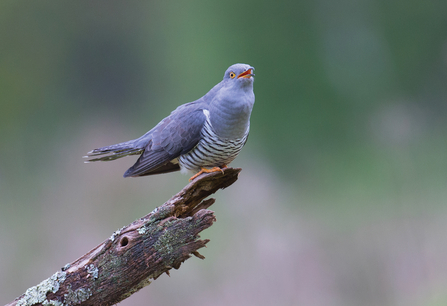
Cuckoo (c) Jon Hawkins
Cuckoos are as famous for their spring and summer ‘cuck-oo’ call (listen in June for it echoing out across the Dales!), as they are for abdicating parental responsibility and laying their eggs in the nest of an unsuspecting host.
The once-familiar call of the cuckoo is disappearing from the British countryside, as cuckoos are in decline and on the red list for their UK conservation status. Loss of natural UK habitat and scarcer insect food have played a part, but cuckoos are now also facing increasing problems on migration to Africa due to frequent drought conditions in Spain.
Where to see (or hear): Ashes Pasture. Spring/summer.
Ring ouzel
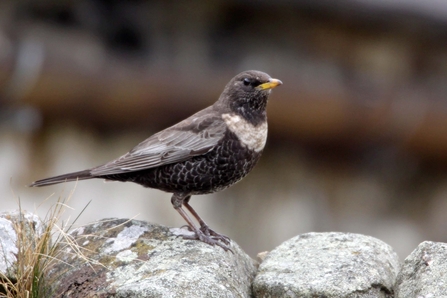
Ring ouzel (c) Margaret Holland
Ring Ouzels are slightly smaller and slimmer than a blackbird, and very shy. Males have distinctive black plumage with a pale wing panel and striking white breast band. The ring ouzel is mostly an upland bird, where it breeds in steep sided-valleys, crags and gullies, and its English distribution is solely northern upland England.
Breeding begins in mid-April and continues through to mid-July, and nests are located on or close to the ground in vegetation (typically in heather), in a crevice, or sometimes in a tree. They are in the red band for the UK conservation status list and numbers are declining dramatically, having fallen more than 70% between 1990 and 2010.
When to see: Summer.
Dotterel
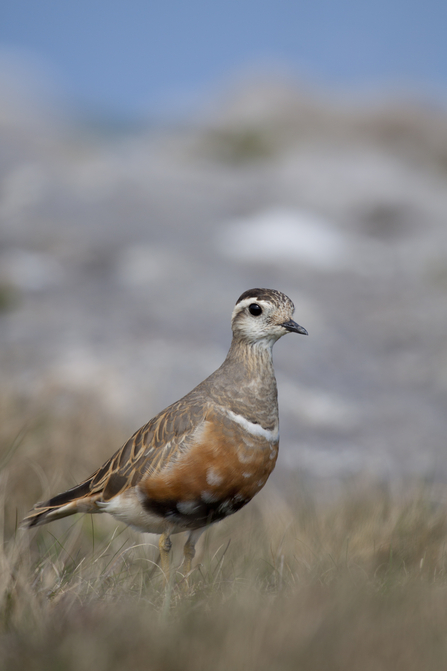
Dotterel (c) Tom Marshal
Dotterels are unusual because the adult female is brighter than the male, mirroring the role-reversal seen in how they raise their young. Adults have largely grey-brown upperparts and bright chestnut belly, with a white chest band, throat and eyestripe which contrasts with their dark cap. When migrating in spring, this wading member of the plover family is often seen in groups, or 'trips', at traditional stopping places.
They are a red-listed bird and are usually only seen passing through the upland Dales during spring and summer migration. Recent sample surveys estimate that the population has halved in the last 30 years, and their preference for montane habitats makes them sensitive to climate change.
When to see: Late spring, during migration.
Snow bunting
Snow bunting (c) Derek Moore
The snow bunting breeds further north than any other small bird in the world.
Snow buntings are easy enough to identify as they are large songbirds, usually with bold white in the wing and a variety of seasonal plumages. They have a shrill, rolling trill, and particularly thick plumage. And they crouch when they walk, so that their feathers cover part of their legs — an adaptation to heat loss.
They are ground-nesting birds that are uncommon in the UK, amber on the list of conservation concern, and seen largely in winter.
When to see: Winter.
Black grouse
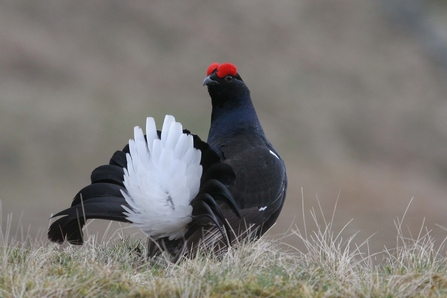
Black grouse (c) Margaret Holland
The male black grouse, or 'blackcock', is famed for its display behaviour, known as 'lekking'. A sight to behold, it fans out its tail and struts its stuff to show its dominance.
Black grouse are about the same size as a female pheasant and lay a clutch of around five eggs in May. They are found on uplands in the north of England, North Wales and Scotland, and are on the red list of conservation concern.
With small populations found along the moorland edge, black grouse were once widespread throughout the Dales. But deteriorating habitat and changing conifer woodlands has caused a big drop in numbers.
Management work by a number of organisations, landowners, land managers (including shooting estates in the core Black Grouse areas) in upland Yorkshire has resulted in a significant increase in numbers — from around 50 lekking males in the late 1990s to around 150 males in recent years.
Unfortunately a combination of wet weather during the main hatching period and heavy snow during the winter has had a detrimental impact on this reestablished population.
When to see: Winter.
Donate today and help us create a truly Wild Ingleborough!
Incredible insects of Ingleborough
From mid-spring, the wildflowers buzz with bees and butterflies. Our hope is for these carpets of flowers to spread from their isolated fragments across the grassland plains of the Ingleborough massif, painting the landscape in a pastel blush to herald the coming of summer.
The unique habitats of Ingleborough already support diverse populations of invertebrates, including small pearl-bordered fritillary and Northern brown argus butterflies.
A joined up landscape with more flowers will support and encourage more of them.
Northern brown argus butterfly
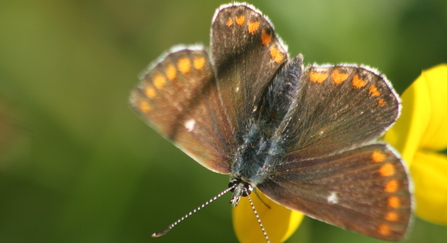
Northern brown argus © Tom Hibbert
A warm, deep chocolate brown colour, with striking white wing margins, the Northern brown argus butterfly's average wingspan is around 30mm.
They tend to be linked to common rock-rose on limestone grassland and limestone pavement habitats, and are found mainly in the uplands of the UK — and specifically in Ingleborough, Grassington and Settle in Yorkshire. The Northern brown argus butterfly is listed as a high-priority species.
Where to see: Southerscales, Brae Pasture, NE land (Scar Close) from June onwards.
From a single insect on a single tree…
One summer, the Wild Ingleborough team were out checking the success of the new trees we had planted to connect and extend the existing woodland fragments on Ingleborough. One of the tiny willows had already become home to caterpillars and spiders, and as we watched a meadow pipit came in to feast.
Our one small act of planting a tree was already creating a habitat in itself, the first link in a newly wilder food chain.
Our work is the catalyst that is giving nature the nudge and support to self-heal, and become more resilient.
Almost 80 years of conservation show us that if you create the right conditions in even the smallest space, wildlife will find a home. From there it needs a network for recovery — a bigger, better and more joined up space for a wilder future.
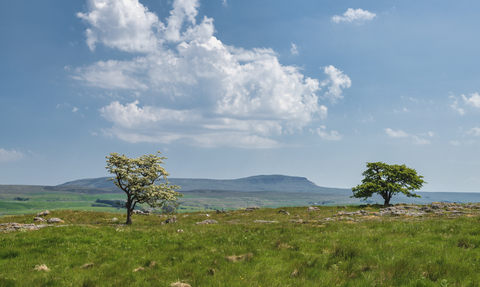
Ashes Shaw & Pen-y-Ghent (c) John Potter

